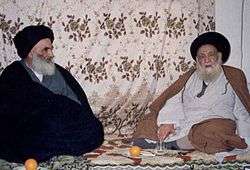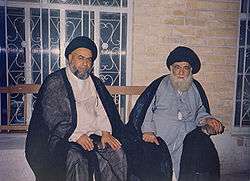Abu al-Qasim al-Khoei
Grand Ayatollah Sayyid Abu al-Qasim al-Musawi al-Khoei (/ˈɑːbuː æl ˈkɑːsɪm æl ˈhuːi/ (![]()
Grand Ayatollah Sayyid Abu al-Qasim al-Khoei | |
|---|---|
السيد أبو القاسم الموسوي الخوئي | |
.jpg) Abu al-Qasim al-Khoei in his office at Najaf, 1970's | |
| Personal | |
| Born | November 19, 1899 |
| Died | August 8, 1992 (aged 92) |
| Resting place | Imam Ali Shrine |
| Religion | Islam |
| Children |
|
| Parents | Ali-Akbar al-Khoei (father) |
| Jurisprudence | Twelver Shia Islam |
| Main interest(s) | Religious jurisprudence |
| Muslim leader | |
| Based in | Najaf, Iraq |
| Period in office | 1970–1992 |
| Predecessor | Muhsin al-Hakim |
| Successor | Abd al-A'la al-Sabziwari |
| Website | Official website |
After the death of Muhsin al-Hakim, he became the spiritual leader of much of the Shia world until his death in 1992. He was succeeded briefly by Abd al-A'la al-Sabziwari, until his death in 1993. Then his former student, Ali al-Sistani, took leadership of the seminary, whereby many of his followers became followers of al-Sistani.[3][4]
Biography
Born in the Iranian city of Khoy, West Azerbaijan province in 1899, Khoei grew up in Iran. Around the age of 13, he moved to Iraq and took up residence in the holy city of Najaf where he began studying Shia theology with the scholars of that city. He eventually attained the rank of Ayatollah and was subsequently made a marja. Khoei would continue to live in Najaf, becoming a teacher for the remainder of his life, and overseeing the studies of scholars who would be qualified to issue fatwas based on Shia theology.
Due to his prominent position as a teacher and scholar in Najaf, he became an important leader of worldwide Shias. He was made the most prominent Grand Ayatollah in 1971 after the death of Muhsin al-Hakim. In this position, he became a patron of numerous institutions across the globe that sought to provide welfare, and also provided scholarships to theological students from across the Muslim world.
He is considered as the architect of a distinct school of thought in the principles of jurisprudence and Islamic law, and one of the leading exponents of 'kalam'-scholastic theology- and 'rijal'- study of the biographies of transmitters of ahadith, the prophetic traditions, 'fiqh'- jurisprudence- and 'tafseer'- exegesis of the Qur'an. His interests included astronomy, mathematics, and philosophy.
Al-Khoei's status as the pre-eminent scholar of his age did not go unchallenged. In the 1970s, Grand Ayatollah Mohammed Al-Shirazi, a radical theologian based in Karbala had a long running feud with Al Khoei and his fellow clerics in Najaf over the legitimacy of theocratic rule. The dispute resulted in Al-Khoei seeking to dismiss Al Shirazi's status as a religious scholar.[5]
After the Persian Gulf War, Khoei was arrested by Saddam Hussein during the mass Shia uprising that followed the defeat of Iraqi forces. While under arrest, he was taken to Baghdad and forced to make public appearances with Saddam Hussein. Hussein eventually allowed Khoei to return to Najaf, but he was placed under house arrest. Khoei died on 8 August 1992 in Najaf at the age of 92.[6] His funeral was led by his student Ali al-Sistani. He was buried in Shrine of Imam Ali in Najaf.[7]
Legacy
Welfare
He was fervently dedicated to establishing welfare, social, cultural, and educational institutions for Muslims worldwide. The following are some of the institutions he established:
- Imam al-Khoei Islamic Center in Queens, NY.
- al-Iman School in Queens, New York.
- As-Sadiq and Az-Zahra Schools in London.
- Imam al-Khoei Islamic Center in London, U.K
- Jamia-tul-Kauthar in Islamabad.
- Darul Hikmah in Najaf.
- Madinatul Ilm in Qom. It is considered one of the biggest theology centres in the Shia world. The complex comprises the school building and living quarters capable of accommodating 500 families.
- As-Sayyid al-Khoei Center in Bangkok.
- As-Sayyid al-Khoei Center in Dhaka.
- Imam al-Khoei Orphanage in Beirut.
- Imam-e-Zamana Mission in Hyderabad.
- Najafi House in Mumbai.
He was also the patron of about 1,000 grant-maintained students of theology from Iraq and other countries like Lebanon, Iran, Syria, Persian Gulf States, India, Pakistan, Afghanistan, South East Asia. He provided financial support for maintaining the schools including boarding expenses, teachers' salaries and lodging costs.
Students

Former student Ali al-Sistani is currently the most senior Shia cleric in Iraq and widely regarded as "wield[ing] enormous power over Iraq's Shia majority."[8] The degree of success of his articulation of moderate Shia politics in Iraq have been said to be "in no small part traceable to the legacy of his mentor and teacher", al-Khoei.[9]
Another significant student of al-Khoei, is Muhammad-Sadiq Rohani, who also shared a close relationship with al-Khoei.[10] He is also currently considered one the highest religious authorities in Iran, alongside Waheed Khurasani. However his influence is limited due to his stance with the Islamic republic.[11]
Works
Khoei wrote on various topics, ranging from Islamic jurisprudence to mathematics and astronomy and was a prolific writer in these disciplines. He wrote 37 books and treatises, most of which have been published. His works include:
- Lectures in the Principles of Jurisprudence - 10 volumes
- Biographies of Narrators of Tradition - 24 volumes.
- Islamic Law - 18 volumes.
- Al-Bayan Fi Tafsir al-Quran (The Elucidation of the Exegesis of The Qur'an and sometimes entitled The Prolegomena to the Quran)
- Minhaju-us-Saliheen (The Path of the Righteous) - 2 volumes, reprinted 78 times (guide book on religious practice and law) .
- Anthology of Religious Questions - Concise version of the Path of the Righteous - in Arabic, Urdu, Persian, English, Turkish, Thai, Malay, Indonesian, and Gujarati.
- Mabani al-Istinbat (Edifices of Deduction) Principles of Jurisprudence.
- Ajwad-at-Taqrirat (The Best of Regulations) Principles of Jurisprudence.
- Sharh-el-Urwatul-Wuthqa (Commentary on The Steadfast Handle) - Jurisprudence.
- Treatise on Suspected Attire - Risala fil Libas Al-Mashkok, Evidential Jurisprudence.
- Nafahat-ul Ijaz (the Fragrance of Miracles), in defence of the Qur'an.
Internet
Personal life

al-Khoei was married and had seven sons:
- Jamal al-Din. He was al-Khoei's eldest son, and spent his life in the service of his fathers marja'iya. He passed away in Tehran after being diagnosed with cancer, in 1984. He was buried in the Fatimah Masumah shrine in Qom. His notable works are: Sharh Kifayat al-Usul, Bahth Fi al-Falsafa Wa Ilm al-Kalam, Sharh Diwan al-Mutanabi.
- Ali al-Khoei. He was killed young in a car accident between Baghdad and Najaf.
- Abbas
- Abd al-Sahib. Current secretary general of the Imam al-Khoei Foundation in London.[12]
- Muhammad-Taqi. He was the secretary general of the Foundation in 1989. He was placed under house arrest with his father after the 1991 Shaban uprising. Muhammad-Taqi was allegedly assassinated by Saddam Hussein, who set up a car accident, on the night of 21 July 1994. Besides reports of his father's lectures, he has authored Kitab al-Iltizamat al-Taba'iya Fi al-Uqud.[12]
- Abd al-Majid. He emigrated from Iraq soon after the Shaban uprising, and left for London. He became the secretary general of the Foundation after his brother, Muhammad-Taqi's death. Soon after the fall of Baghdad to US forces in 2003, he returned to Iraq with plans to revive Najaf to the glory and splendor it enjoyed under the patronage of his father. However, he was assassinated on April 10, 2003, near the Imam Ali Mosque in Najaf.[12]
- Ibrahim. He was abducted from his house by the Baathist regime after the Shaban uprising, in 1991.[12]
References and notes
- Tarrad, Hamada; Abd al-Hasan, Amin (2004). al-Imam Abu al-Qasim al-Khoei: Za'im al-Hawza al-Ilmiya [Imam Abu al-Qasim al-Khoei: Head of the Islamic Seminary] (in Arabic). Mu'sasat al-Imam al-Khoei al-Khayriya.
- al-Waseti, Ahmed (1998). Sirat Wa Hayat al-Imam al-Khoei [Biography and Life of Imam al-Khoei] (in Arabic). Beirut, Lebanon: Dar al-Hadi.
- Corboz, Elvire (2015-01-20). Guardians of Shi'ism: Sacred Authority and Transnational Family Networks. Edinburgh University Press. pp. 64–5. ISBN 978-0-7486-9145-6.
- al-Shafi'i, Abd al-Malik (2005). Mawqif al-Tashayyu al-Imamiya Min Baqi al-Firaq al-Muslimeen [The Stance of Imami Shiism on the Rest of the Islamic Creeds] (in Arabic). Egypt: Maktabat al-Ridhwan. pp. 227–30.
- Has Kuwait reached the sectarian tipping point?, American Enterprise Institute, August 14, 2013
- Biography of Ayatollah Khoei in English
- Biography of Ayatollah Khoei in English
- Who's who in Iraq: Ayatollah Sistani, 26 August, 2004
- Nasr, Vali (2006). The Shia Revival: How Conflicts within Islam will shape the Future. Norton. p. 145. ISBN 0-393-06211-2.
- al-Shafi'i, Abd al-Malik (2005). Mawqif al-Tashayyu al-Imamiyah Min Baqi Firaq al-Muslimeen [The Stance of Shiism On Other Muslim Sects] (in Arabic). Cairo, Egypt: Maktabat al-Rudhwan. p. 229.
- "Visiting Iran's ayatollahs at Qom". BBC News. 2009. Retrieved 2010-01-04.
- "Usratuh - Awladih" [His family - His sons]. www.alkhoei.net. Retrieved 2020-04-11.
External links
| Wikimedia Commons has media related to Abu al-Qasim al-Khoei. |